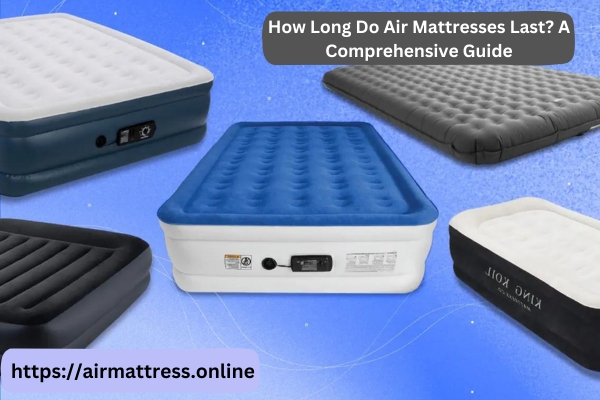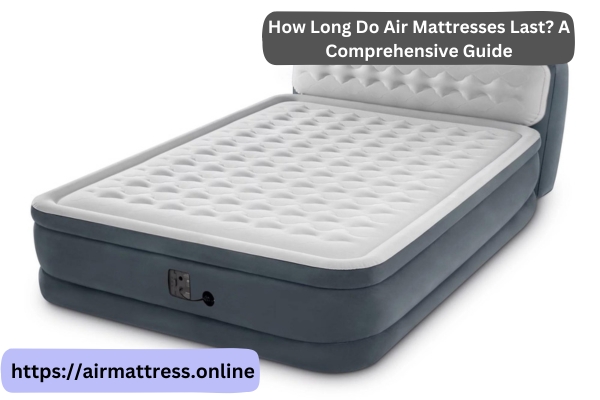How Long Do Air Mattresses Last?
Air mattresses have become a popular choice for temporary bedding solutions, such as camping trips, overnight guests, or for those who need a portable sleep option. However, one common question that arises is: How long do air mattresses last?
In this article, we will provide a comprehensive guide to help you understand the lifespan of an air mattress, factors that affect its durability, and tips to prolong its longevity.
Whether you’re a frequent user or considering purchasing an air mattress, this information will help you make informed decisions and ensure a comfortable sleep experience for years to come. (By On Amazon)
-
Quality of Construction:
The quality of construction plays a vital role in determining the lifespan of an air mattress. Higher-quality air mattresses typically last longer due to superior materials and construction methods. Look for models made from durable materials such as puncture-resistant PVC or reinforced vinyl. Thicker materials and multiple air chambers can also enhance durability and support.
-
Frequency of Use:
The frequency of use is a significant factor that affects the lifespan of an air mattress. An air mattress used occasionally for guests or camping trips may last longer than one used as a primary bed every night. Frequent usage puts more strain on the mattress, increasing the chances of wear and tear. If you plan to use an air mattress regularly, consider investing in a higher-quality model designed for long-term use.
-
Weight Capacity:
The weight capacity of an air mattress is an important consideration. Overloading the mattress beyond its recommended weight limit can lead to leaks, sagging, and premature damage. Always follow the manufacturer’s guidelines regarding weight limits to ensure the longevity of your air mattress.
-
Proper Inflation and Deflation:
Proper inflation and deflation techniques are crucial for maintaining the integrity of an air mattress. Overinflating the mattress can strain the seams and valves, while underinflation can cause discomfort and put excessive pressure on specific areas. Follow the manufacturer’s instructions for inflation and deflation, and avoid using excessive force or sharp objects during the process.

-
Storage and Maintenance:
Proper storage and maintenance are key to prolonging the lifespan of an air mattress. When not in use, store the mattress in a clean and dry environment, away from sharp objects that could puncture it. Regularly inspect the mattress for any signs of damage or leaks. Clean the mattress according to the manufacturer’s guidelines, and avoid exposing it to extreme temperatures or direct sunlight, as these can weaken the materials.
-
Environmental Factors:
Environmental factors can also influence the durability of an air mattress. Extreme temperatures, humidity, and exposure to moisture can weaken the materials over time. If using an air mattress outdoors, consider placing a protective barrier, such as a tarp or groundsheet, underneath to prevent direct contact with rough or damp surfaces.
-
Warranty and Customer Reviews:
When purchasing an air mattress, consider the warranty provided by the manufacturer. A longer warranty period often indicates confidence in the product’s durability. Additionally, reading customer reviews can provide insights into the experiences of other users and help you gauge the longevity of a specific air mattress model.
8. Type of Air Mattress:
The type of air mattress can impact its lifespan. There are two main types: traditional air mattresses and airbeds with built-in pumps. Traditional air mattresses typically have a shorter lifespan compared to airbeds with built-in pumps. The built-in pump design reduces the risk of valve damage and makes inflation and deflation easier, contributing to the longevity of the mattress.
9. Careful Handling:
Proper handling of an air mattress can help prolong its lifespan. Avoid dragging the mattress across rough surfaces, as this can cause abrasions and punctures. Lift and carry the mattress carefully to prevent unnecessary strain on the seams and valves. Be mindful of sharp objects and remove them from the surrounding area before setting up the mattress.
10. Repairing Leaks:
In the event of a leak, it’s important to repair it promptly to prevent further damage. Most air mattresses come with a repair kit that includes patches and adhesives. Follow the instructions provided by the manufacturer to effectively repair any leaks. Regularly inspect the mattress for potential leaks, especially after extended use or when storing it for a long period.

11. Considerations for Different Environments:
If you plan to use an air mattress outdoors or in rugged environments, it’s important to choose a model specifically designed for such conditions. Look for air mattresses that are labeled as “outdoor” or “camping” models, as they are typically more durable and resistant to punctures. These models often have reinforced materials and additional features to withstand rough surfaces.
12. Replacement Parts:
Some air mattress manufacturers offer replacement parts, such as valves and caps, which can extend the lifespan of your mattress. If a specific part becomes worn or damaged, check if replacement parts are available from the manufacturer. This can be a cost-effective solution rather than replacing the entire mattress.
13. Considerations for Heavy-Duty Use:
If you anticipate heavy-duty use of an air mattress, such as accommodating heavier individuals or frequent use by multiple guests, it’s advisable to invest in a heavy-duty or commercial-grade air mattress. These mattresses are designed to withstand higher weight capacities and frequent usage, providing greater durability and longevity.
14. User Weight Distribution:
Uneven weight distribution on an air mattress can contribute to premature wear and damage. Encourage users to distribute their weight evenly across the surface of the mattress. This can help prevent excessive strain on specific areas and extend the overall lifespan of the mattress.
15. Manufacturer Guidelines:
Always refer to the manufacturer’s guidelines and instructions for proper care, maintenance, and usage of your specific air mattress model. Following these guidelines will help maximize the lifespan of the mattress and prevent unnecessary damage.
Conclusion:
The lifespan of an air mattress depends on various factors, including the quality of construction, frequency of use, weight capacity, proper inflation and deflation techniques, storage and maintenance practices, and environmental factors.
While some air mattresses may last for several years with proper care, others may require replacement sooner. Investing in a higher-quality air mattress and following recommended guidelines for usage and maintenance can significantly extend its lifespan.
By understanding these factors and implementing the tips provided, you can enjoy a comfortable and durable sleep experience with your air mattress for an extended period.
(THE DISADVANTAGES OF AIR MATTRESSES: ARE THEY WORTH THE HYPE?)

